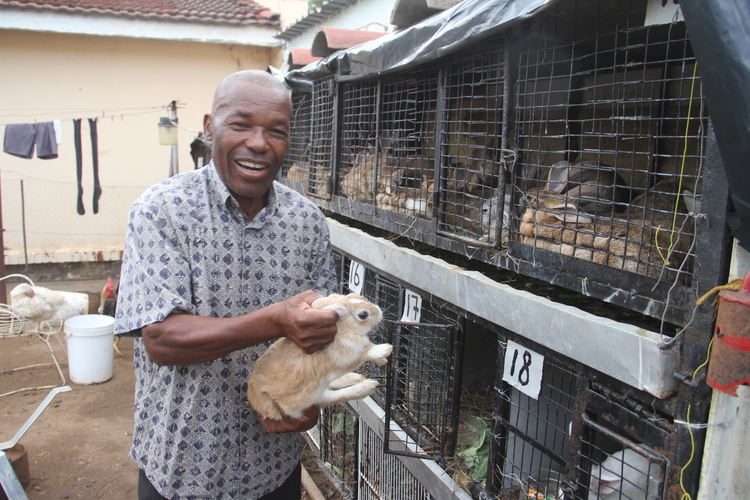
The Sunday Mail

Tendai Chara
As soon as he arrives at his modest home in one of Harare’s medium-density suburbs, Mr Mike Medicine Gwara, a retired banker who is now practicing real estate consultancy, hurriedly changes into overalls and dashes to the backyard.
He immediately starts working, cleaning rabbit cages and making sure that the animals have enough food and fresh water to last until the next morning.
Mr Gwara is one of the many urbanites that are commercially rearing rabbits in their backyards.
Previously, rabbits were mainly kept for family consumption with some people using them as pets. Few people considered rabbits as a source of income.
Rabbit farming, also known as cuniculture, is growing steadily in Zimbabwe since farmers have recognised a gap in the market for the supply of rabbit meat.
What started off as a hobby has now become a livelihood, not only for the Gwara family but also for villagers in Musana, Mashonaland East.
Initially, Mr Gwara only had five rabbits. Now his cages can accommodate more than 100 rabbits.
“I started this project in August 2015 and so far the results have been encouraging. Rabbit farming is one of the ways of realising the Zim-Asset goals since it creates employment and also provides nutritional needs to the family,” Mr Gwara said.
Barely some three months into the project, Mr Gwara keeps rabbit breeds such as the Californian white, Chinchilla and the New Zealand White. Rabbit breeds vary in body shape, fur colour and behavioural characteristics.
According to Mr Gwara, rabbit production is not capital intensive, it has low production costs and creates employment. He says it empowers communities and alleviates poverty.
“I run the Musana/Bindura Orphanage Centre and rabbit production has transformed the lives of seven widows and 83 orphans. We empowered them by giving them rabbits and I am happy to say that the orphanage is now almost self-reliant,” said Mr Gwara.
He has also donated rabbits to some villagers who are now into commercial production.
Each villager was given two female rabbits (does). They have access to male rabbits, which are known as bucks. A buck can service up to 10 does.
On average, a doe can produce between five and eight baby rabbits (kittens) at a time.
Rabbits grow rapidly and they require less food when compared to other domesticated animals.
According to Mr Gwara, rabbit producers are assured of a ready market.
“Rabbit production is the simplest way of empowering communities. The market is there and the costs are low. As it stands, farmers are not capable of meeting demand. I did a market research and it revealed that farmers have a long way to go in terms of meeting demand,” he said.
Rabbit urine can also be processed into foliar fertiliser and Mr Gwara is running a thriving horticultural project and making use of the rabbit urine as fertiliser.
“We use the rabbit urine as fertiliser for our garden and then use the vegetables from the garden to feed the rabbits. We also use the left-overs to feed our free range chickens,” he said.
Rabbit skin is used to make leather while the offals make pet food.
However, rabbit production requires a farmer who is hands-on and is always available.
“The farmer needs to keep records on almost every other detail regarding breeding and feeding. Rabbits need a constant supply of fresh water and must not be overfed. Therefore, rabbit production is for those who are passionate about it,” Mr Gwara said.
He said if not kept well, the rabbits’ mortality rate becomes high.
Rabbits are being sold for between $8 and $15, depending on the market.
Mr Gwara urged Government to empower youths through initiating low-cost rabbit production projects.
“One can never go wrong with rabbits, their production is a business worth pursuing. One must be consistent and disciplined as the profit margins are very high,” he concluded.
Advantages of rabbit meat
Rabbit meat is considered a delicacy in hotels and upmarket restaurants.
The RPAZ is aiming at making rabbit meat readily available in supermarkets, just like other meats.
Rabbit farming has great potential to create employment, economically empower communities and to alleviate poverty.
It can also contribute meaningfully to the overall economic revival of the country.
According to online sources, rabbit meat has the following advantages:
Cholesterol level in rabbit meat is much lower than in chicken, turkey, beef, pork.
l Rabbit meat has the highest percentage of easily digestible protein, domestic rabbit meat is the most nutritious meat known to man.
l Rabbit meat is the all white meat that has the lowest fat, low calorie, less sodium content and high meat-to-bone ratio.
l Rabbit meat has been used and is suitable for special diets such as those for heart disease patients, the aged, low sodium and weight reduction.
l Rabbits will produce plus 2kg of meat on the same feed and water as a cow will produce 500 g of meat on the same feed and water.
l Rabbit urine can be processed into foliar fertiliser, the skin into leather and the offals into pet food.
Despite these advantages, the consumption of rabbit meat has remained low, mainly due to lack of availability of consistent supply to the market.
Middlemen have taken advantage of this apparent scarcity and are selling rabbit meat at unreasonably high prices.



